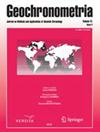不同红外后红外光谱法钾长石测年方案获得的等效剂量的比较
IF 0.9
4区 地球科学
Q3 Earth and Planetary Sciences
引用次数: 1
摘要
摘要采用后红外(IR)激发发光信号(pIRIR)对黄土样品中的钾长石进行了5种测年方法。其中两个是单等分再生剂量方案(SAR),两步pIRIR刺激,第一次IR刺激在50°C或200°C,第二次在290°C (pIR50IR290, pIR200IR290)。其中两种是SAR方案,在250°C或300°C的多次高温下进行五步或六步红外刺激(MET-pIRIR250, MET-pIRIR300)。最后一种是使用MET-pIRIR300信号的多重等分再生剂量(MAR)方案,并在试验剂量前进行500°C热处理(“加热MAR”)。结果表明,当样品的等效剂量(De)小于500 Gy时,所有方案的结果一致;然而,当De超过750 Gy时,所有SAR方案都低估了De,其中pIR50IR290信号的低估程度最高,而pIR200IR290、MET-pIRIR250和MET-pIRIR300信号的De值和低估程度相似。讨论了SAR De低估的可能原因。我们建议,对于De超过750 Gy的样品,只有“带热的MAR”方案是合适的。本文章由计算机程序翻译,如有差异,请以英文原文为准。
Comparison of equivalent doses obtained with various post-IR IRSL dating protocols of K-feldspar
Abstract Five dating protocols with post-infrared infrared (IR) stimulated luminescence signals (i.e. pIRIR) were performed on the K-feldspar of loess samples. Two of them were the single-aliquot regenerative-dose protocol (SAR) with two-step pIRIR stimulation, with the first IR stimulation at 50°C or 200°C and the second at 290°C (pIR50IR290, pIR200IR290). Two of them were the SAR protocols with five-step or six-step IR stimulation at multiple elevated temperatures to 250°C or 300°C (MET-pIRIR250, MET-pIRIR300). The final one was the multiple-aliquot regenerative-dose (MAR) protocol with the MET-pIRIR300 signal, together with a 500°C heat treatment administered before the test dose (‘MAR with heat’). The results show that when the equivalent dose (De) of the sample was less than 500 Gy, all of the protocols gave consistent results; however, when De exceeded 750 Gy, all of the SAR protocols underestimated De. The pIR50IR290 signal had the highest degree of underestimation, while the pIR200IR290, MET-pIRIR250 and MET-pIRIR300 signals had similar De values and similar degrees of underestimation. Possible reasons for the SAR De underestimation are discussed. We suggest that only the ‘MAR with heat’ protocol is suitable for samples with De exceeding 750 Gy.
求助全文
通过发布文献求助,成功后即可免费获取论文全文。
去求助
来源期刊

Geochronometria
地学-地球科学综合
CiteScore
2.20
自引率
0.00%
发文量
1
审稿时长
>12 weeks
期刊介绍:
Geochronometria is aimed at integrating scientists developing different methods of absolute chronology and using them in different fields of earth and other natural sciences and archaeology. The methods in use are e.g. radiocarbon, stable isotopes, isotopes of natural decay series, optically stimulated luminescence, thermoluminescence, EPR/ESR, dendrochronology, varve chronology. The journal publishes papers that are devoted to developing the dating methods as well as studies concentrating on their applications in geology, palaeoclimatology, palaeobiology, palaeohydrology, geocgraphy and archaeology etc.
 求助内容:
求助内容: 应助结果提醒方式:
应助结果提醒方式:


